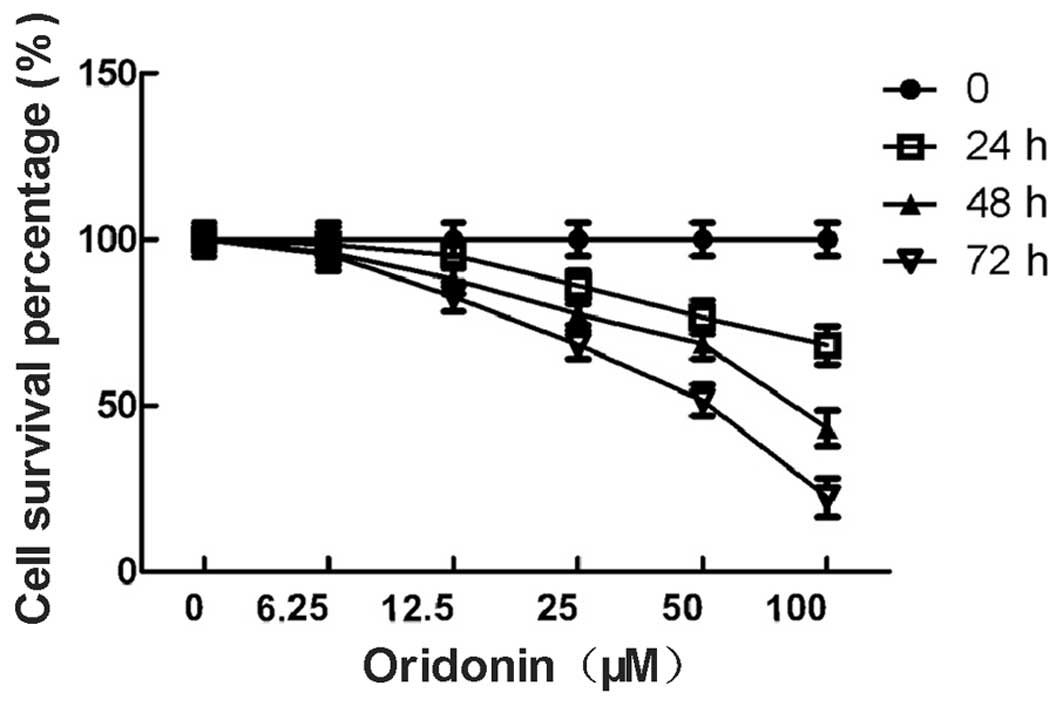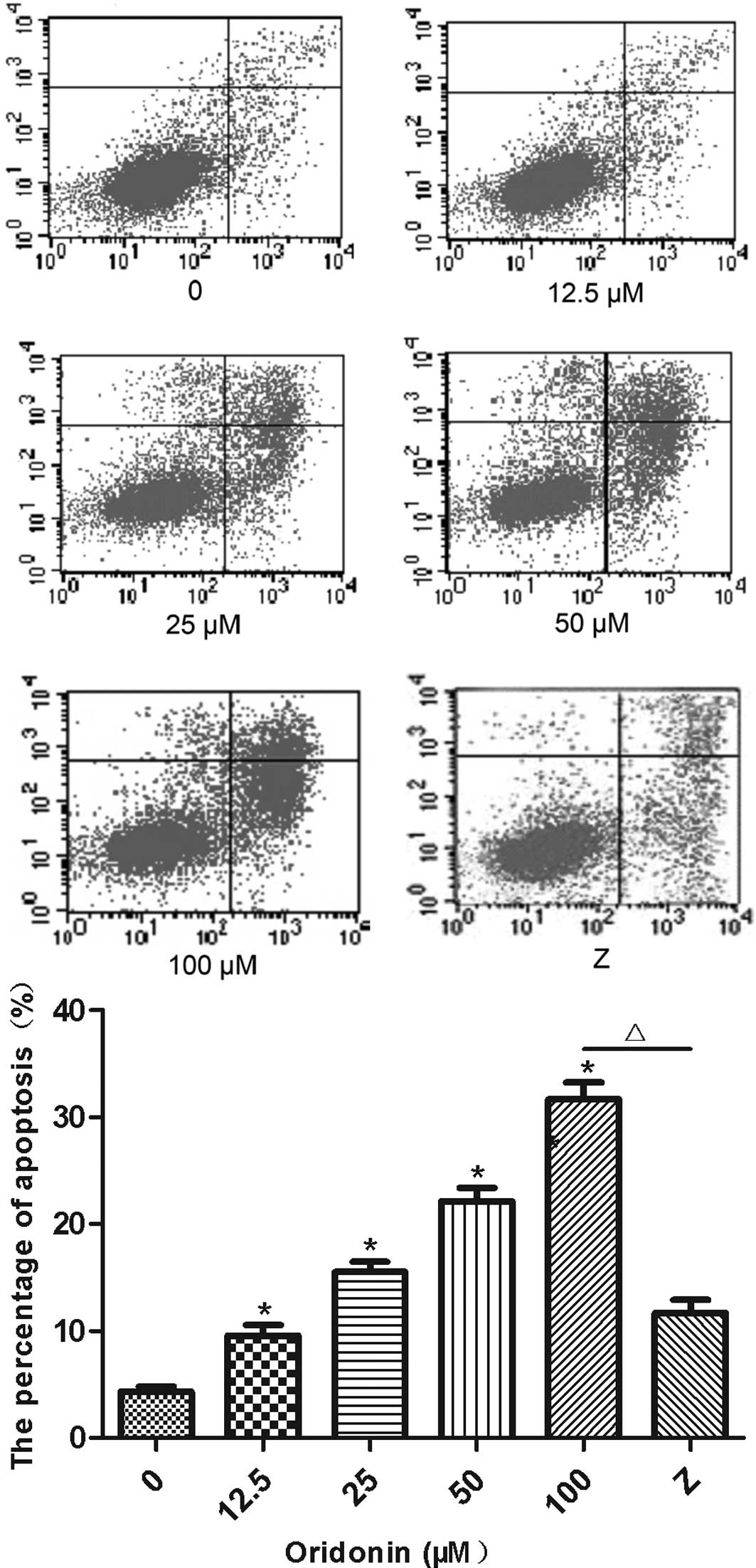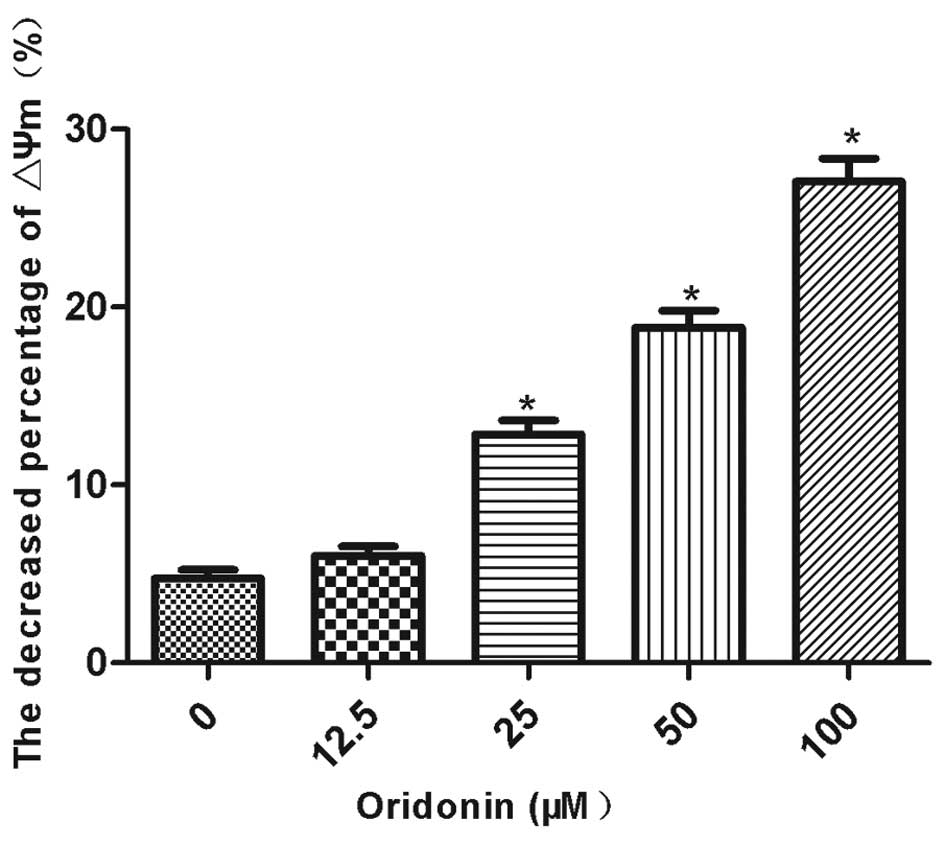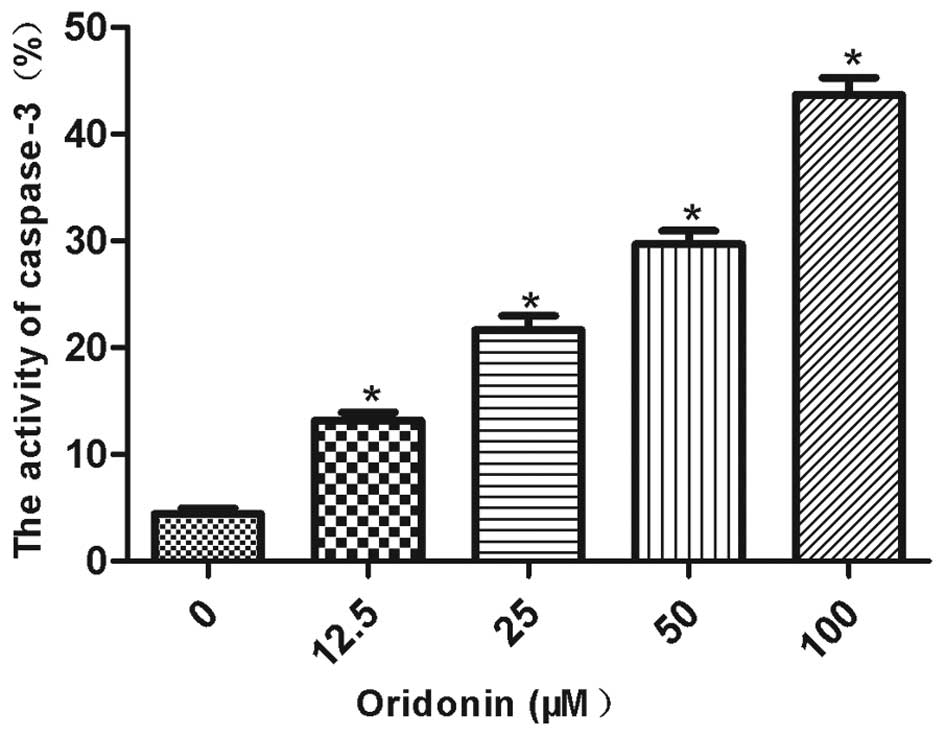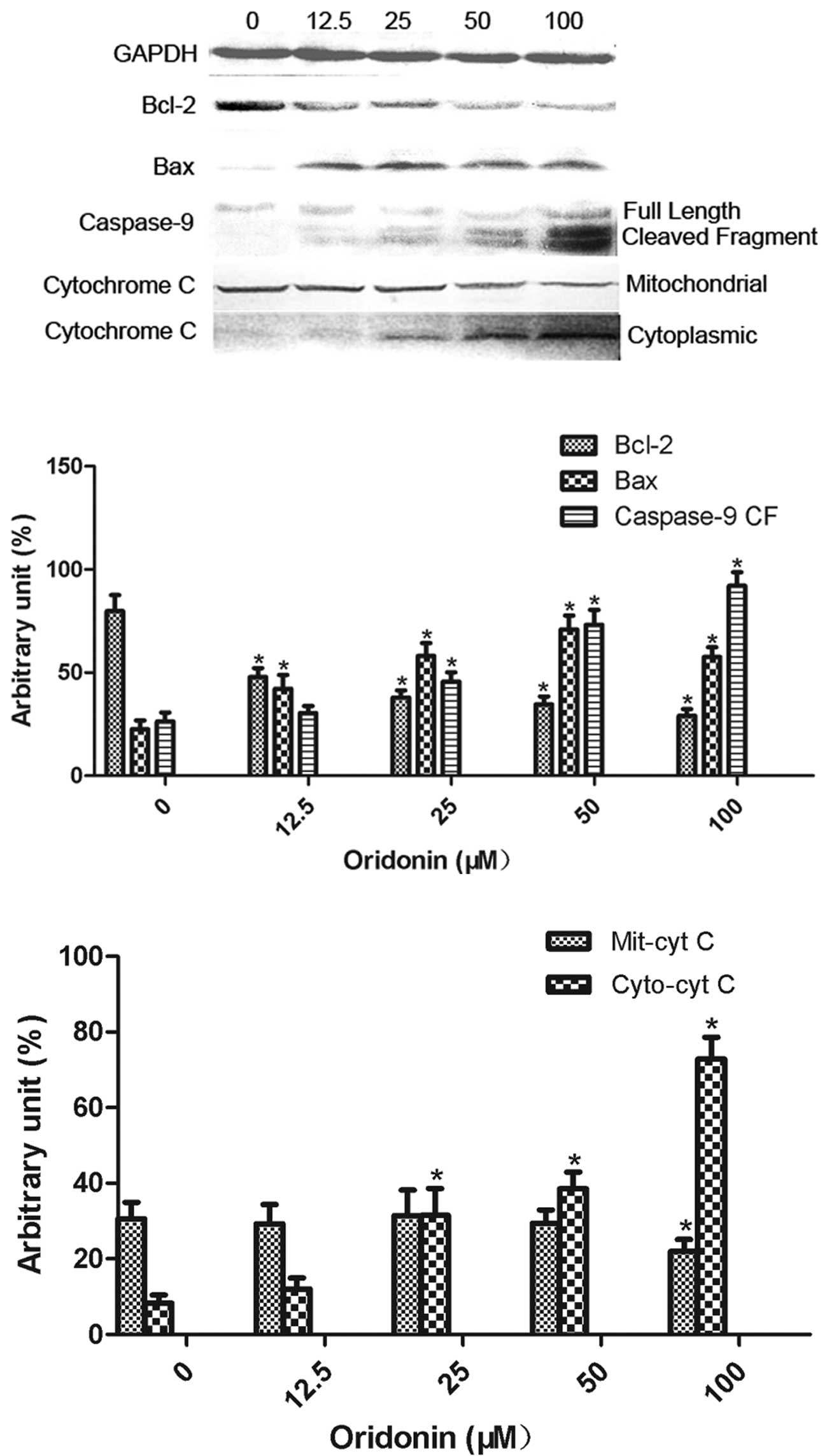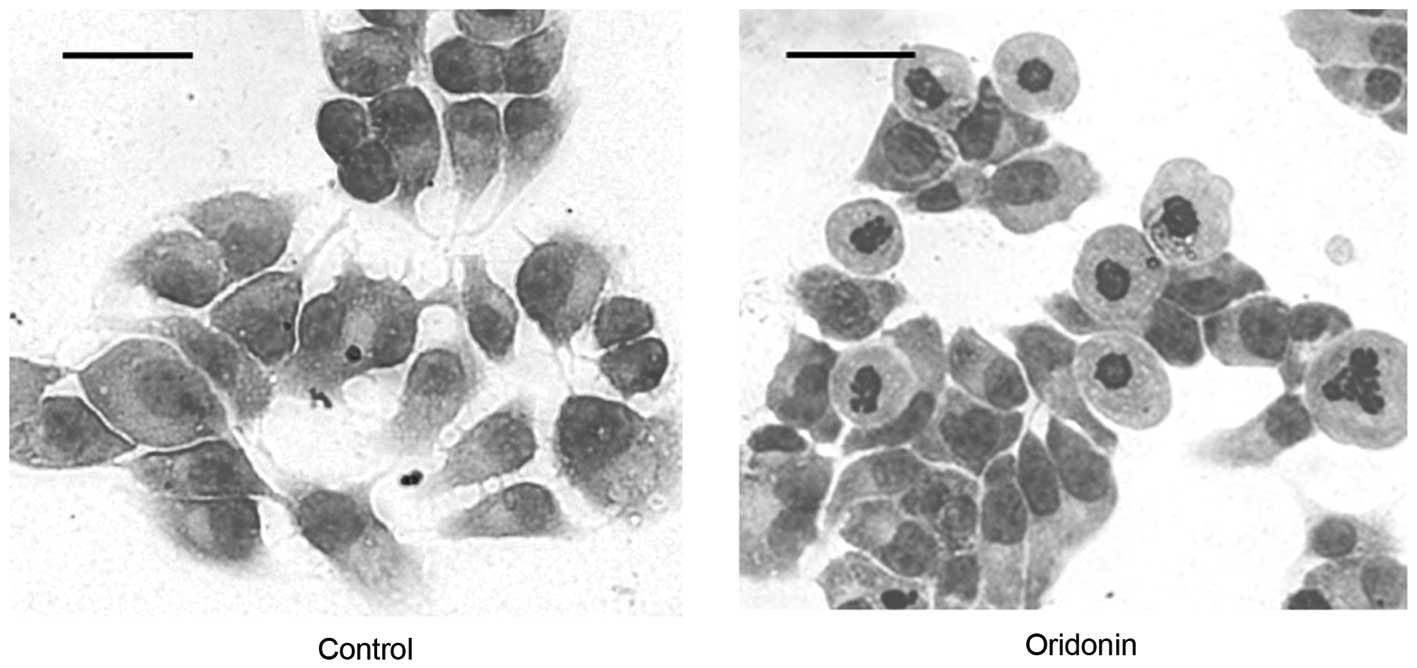Oridonin induces the apoptosis of metastatic hepatocellular carcinoma cells via a mitochondrial pathway
- Authors:
- Published online on: August 23, 2013 https://doi.org/10.3892/ol.2013.1541
- Pages: 1502-1506
Abstract
Introduction
Hepatocellular carcinoma (HCC) is one of the most frequently occurring cancers in the world, resulting in approximately one million deaths every year (1). The majority of liver cancers are diagnosed at later stages due to the absence of symptoms in patients and an incorrect liver disease diagnosis. Surgical options for patients with HCC include a resection of the primary tumor and liver transplantation (2). As HCC is typically diagnosed at an advanced stage, a resection of the primary tumor is typically not an option and >80% of HCC patients have recurrent disease within two years following the surgery. Recurrence and metastasis are the two main causes of patient mortality. Recent advances in our understanding of the biology and signaling pathways of HCC have led to apoptosis induction being considered as a new treatment strategy for HCC (3).
Studies have focused on Rabdosia rubescens, which is used as a herbal medicine, due to its antitumor effects and lack of serious side-effects (4,5). Oridonin, a diterpenoid that is isolated from R. rubescens, has shown antitumor effects in several malignant tumors, including breast and cervical carcinoma and lymphoma (6,7). Oridonin has been demonstrated to induce apoptosis in HepG2 HCC cells, which have a moderate metastatic potential (8,9). However, the effect of oridonin on human HCC cell lines with a high metastatic potential has not been determined. Therefore, the present study investigated the effect of oridonin on the apoptosis of the highly metastatic MHCC97-H HCC cell line and the underlying molecular mechanism involved.
Materials and methods
Reagents
High glucose Dulbecco’s modified Eagle’s medium (DMEM) and fetal calf serum (FCS) were purchased from HyClone (Beijing, China). The Annexin V Alexa Fluor 488/propidium iodide (PI) Apoptosis, MTS/PMS Cell Proliferation Assay, Active Caspase-3 Staining and Cytoplasmic and Mitochondrial Protein Extraction kits were purchased from Invitrogen (Carlsbad, CA, USA), Promega (Madison, WI, USA), Biovision (Milpitas, CA, USA) and Sangon Biotech Co. Ltd (Shanghai, China), respectively. The Z-LEHD-FMK caspase-9 inhibitor, rhodamine-123 and 3,3′-diaminobenzidine tetrahydrochloride (DAB) were purchased from R&D Systems (Minneapolis, MN, USA), Sigma Chemical Co. (St. Louis, MO, USA) and Dako (Glostrup, Denmark), respectively. Cytochrome c, Bcl-2 and Bax monoclonal antibodies and horseradish peroxidase (HRP)-conjugated secondary antibodies (goat-anti-rabbit and goat-anti-mouse) were purchased from Epitomics (Burlingame, CA, USA). Caspase-9 and glyceraldehyde 3-phosphate dehydrogenase monoclonal antibodies were purchased from Cell Signaling (Danvers, MA, USA). Oridonin (Lot, 111721–200501; 97% purity) was obtained from the Beijing Institute of Biological Products (Beijing, China). Oridonin was prepared in dimethyl sulfoxide (DMSO).
Cell culture
The human MHCC97-H HCC cell line was obtained from the Hepatic Carcinoma Institute, Fudan University (Shanghai, China). The MHCC97-H cells were cultured in DMEM supplemented with 10% FCS at 37°C in a humidified atmosphere, with 5% CO2(10). All the experiments were performed with cells in the logarithmic growth phase. The DMSO concentration in the cell cultures (<0.5%) did not affect the cell viability.
MTS/PMS assay for cell proliferation
The MHCC97-H cells were seeded into 96-well plates at a density of 1×105 cells/ml. The cells were treated with oridonin at concentrations of 6.25, 12.5, 25, 50 and 100 μM for 24, 48 and 72 h. The untreated cells served as the controls. Proliferation was determined using the MTS/PMS Cell Proliferation Assay kit, according to the manufacturer’s instructions. MTS/PMS (10 μl) was added to each well and incubated at 37°C for 2 h. The absorbance was measured at 490 nm on a multi-well plate reader. The effect of oridonin on cell proliferation was reported as the cell survival percentage, calculated as absorbance (oridonin-treated group)/absorbance (control group) × 100. The background absorbance of the medium in the absence of the cells was subtracted from the absorbance values for the control and oridonin-treated groups. Each assay was performed in triplicate and the results are presented as the mean ± SD.
Annexin V/PI assay for apoptosis
The MHCC97-H cells (1×105 cells/ml) were seeded onto 6-well plates and treated with oridonin at concentrations of 12.5, 25, 50 and 100 μM for 24 h. In addition, the cells were treated with 100 μM oridonin in the presence of 20 μM Z-LEHD-FMK. The apoptotic cells were detected using the Annexin V Alexa Fluor 488/PI Apoptosis kit, according to the manufacturer’s instructions. The cells were washed twice with ice-cold phosphate-buffered saline (PBS), then resuspended in PBS (100 μl) and incubated with Annexin V labeling solution (5 μl) for 30 min at 4°C in the dark. The cells were incubated in 1X buffer solution (200 μl) and labeled with PI. The percentage of the apoptotic cells was determined by flow cytometry (FACScan; Becton Dickinson Corporation, Franklin Lakes, NJ, USA).
Mitochondrial membrane potential
The MHCC97-H cells were treated with oridonin (12.5, 25, 50 and 100 μM) for 24 h, washed twice with PBS, labeled with rhodamine-123 (1 μg/ml) for 10 min at 37°C and washed twice again with PBS. The mitochondrial membrane potential was determined by flow cytometry.
Caspase-3 activity
The MHCC97-H cells were treated with oridonin (12.5, 25, 50 and 100 μM) for 24 h, washed twice with PBS and then resuspended in PBS (300 μl). Caspase-3 activity was determined using the Active Caspase-3 Staining kit, according to the manufacturer’s instructions.
Western blot
Following oridonin treatment, the MHCC97-H cells were washed twice with PBS, lysed with RIPA buffer on ice and centrifuged at 10,000 × g for 30 min at 4°C. The supernatant was collected and stored at −80°C. The cytoplasmic and mitochondrial proteins were extracted using the Cytoplasmic and Mitochondrial Protein Extraction kit, according to the manufacturer’s instructions. The protein concentration was determined using the BCA Protein Assay kit (Sangon Biotech Co. Ltd). Proteins (20 μg) in an equal volume of 2X sample loading buffer were denatured by boiling for 5 min. Electrophoresis was performed at 70 V for 20 min and then at 100 V for 1 h. The proteins were transferred onto polyvinylidene difluoride (PVDF) membranes (0.22 μm) using the semi-dry transfer method (Trans-blot SD; Bio-Rad Laboratories, Hercules, CA, USA). The PVDF membrane was incubated with primary antibody (1:1,000) overnight, washed three times with PBS supplemented with Tween 20 (PBST) for 10 min, incubated with secondary antibody (1:3,000) for 2 h at room temperature and washed twice with PBST for 10 min. Western blot bands were developed using DAB as the HRP substrate and analyzed using Quantity One 4.6 (Bio-Rad).
Cell morphology
The MHCC97-H cells were treated with 50 μM oridonin at time-points ranging from 24 to 72 h, washed in PBS, dried and stained using a Wright-Giemsa stain. The cell morphology was observed under a light microscope (Leica, Solms, Germany). The untreated cells were used as the controls.
Statistical analysis
The data are presented as the mean ± SD of three independent experiments. Fisher’s least significant difference (LSD) tests were performed using SPSS version 13.0 software (SPSS, Inc., Chicago, IL, USA). The t-test was applied to compare the means from the two groups. An LSD t-test was utilized to compare the means from multiple groups. The correlation between caspase-3 activity and inducing concentrations of oridonin was analyzed by linear correlation analysis. P<0.05 was considered to indicate a statistically significant difference.
Results
Effect of oridonin on the proliferation of MHCC97-H cells
The percentage of viable MHCC-97-H cells in the oridonin-treated group is shown in Fig. 1. The percentage of viable cells was 98.6, 95.3, 86.2, 76.6 and 68.2% for the cells that were treated with 6.25, 12.5, 25, 50 and 100 μM oridonin for 24 h, respectively. The percentage of viable cells was 96.2, 88.1, 77.5, 68.5 and 43.2% for the cells that were treated with 6.25, 12.5, 25, 50 and 100 μM oridonin for 48 h, respectively. The percentage of viable cells was 95.5, 82.8, 68.3, 51.6 and 22.4% for the cells that were treated with 6.25, 12.5, 25, 50 and 100 μM oridonin for 72 h, respectively. The difference between the test group and the control group was significant (P<0.05). The data indicated that the growth inhibitory effect of oridonin on the MHCC97-H cells was dependent on the concentration and the duration of the treatment. The 6.25 μM concentration of oridonin was not included in the further experiments due to the weak anti-proliferative effect.
Effect of oridonin on the apoptosis of MHCC97-H cells
The percentage of Annexin V-positive and PI-negative MHCC97-H cells that were treated with oridonin is shown in Fig. 2. The percentage of the apoptotic cells was significantly higher (P<0.05) for the oridonin-treated cells than for the untreated control cells. Furthermore, oridonin increased the percentage of apoptotic cells in a concentration-dependent manner. The percentage of apoptotic cells (Annexin V-positive and PI-negative) was 9.5, 15.6, 22.2 and 31.7% in the MHCC97-H cells that were treated with 12.5, 25, 50 and 100 μM oridonin for 24 h. Addition of the caspase-9 inhibitor, Z-LEHD-FMK, significantly lowered (P<0.05) the percentage of apoptotic cells that were induced by the 100-μM concentration of oridonin (11.7 vs. 31.7%).
Effect of oridonin on the mitochondrial membrane potential of MHCC97-H cells
The mitochondrial membrane potential was decreased by oridonin in a concentration-dependent manner. The mitochondrial membrane potential was significantly decreased (P<0.05) by 12.9, 18.9 and 27.1% in the MHCC97-H cells that were treated with 25, 50 and 100 μM oridonin, respectively (Fig. 3). By contrast, the decrease in the mitochondrial membrane potential (6.0%) was not significantly different between the 12.5 μM oridonin-treated cells and the control cells. The ratio of the mitochondrial membrane potential prior to and following the oridonin treatment is shown in Fig. 3.
Effect of oridonin on caspase-3 activity of MHCC97-H cells
Oridonin increased caspase-3 activity in the MHCC97-H cells (Fig. 4). Caspase-3 activity was significantly increased (P<0.05) by 13.2, 21.6, 29.7 and 43.6% in the cells that were treated with 12.5, 25, 50 and 100 μM oridonin for 24 h. Caspase-3 activity was positively correlated with the oridonin concentration (r2=0.9538).
Effect of oridonin on the expression of apoptotic proteins in MHCC97-H cells
The effect of oridonin at concentrations of 12.5, 25, 50 and 100 μM on the expression of the apoptosis-related proteins, including Bcl-2, Bax, cytochrome c and caspase-9, is shown in Fig. 5. Bcl-2 expression was significantly decreased (P<0.05) and Bax expression was significantly increased (P<0.05) by all the concentrations of oridonin. The expression of cleaved caspase-9 and cytoplasmic cytochrome c was significantly increased (P<0.05) by oridonin at concentrations of 25, 50 and 100 μM. Oridonin at a concentration of 100 μM significantly decreased (P<0.05) the expression of mitochondrial cytochrome c.
Effect of oridonin on the morphology of MHCC97-H cells
The untreated control MHCC97-H cells had an epithelioid morphology with a large, round or oval nucleus and abundant cytoplasm (Fig. 6; left panel). The morphological alterations that are associated with cells undergoing apoptosis, including cell shrinkage, nuclear fragmentation and chromatin condensation, were observed in the cells that were treated with 50 μM oridonin for 24 h (Fig. 6; right panel). Necrosis was evident in the cells that were treated with 50 μM oridonin for ≥48 h.
Discussion
The present study investigated the apoptotic potential of oridonin in MHCC97-H cells, a human hepatoma cell line with a high metastatic capacity (11,12). Oridonin decreased the number of viable cells and increased the percentage of apoptotic cells. Therefore, oridonin inhibited the proliferation of the MHCC97-H cells by inducing apoptosis. The IC50 of oridonin, which was calculated using the Bliss method (13), was 142.2, 80.8 and 44.6 μM for the 24-, 48- and 72-h treatments, respectively. These data indicate that the growth inhibitory effect of oridonin is concentration- and time-dependent. Zhang et al(14) reported that the MHCC97-H cell line has a higher invasive and metastatic potential than HepG2 and SMMC7721 HCC cell lines. Previously, we reported that the 24 h IC50 of oridonin in HepG2 cells was 27.6 μM (8). These findings are in agreement with those of Huang et al(9). Taken together, these findings indicate that the effective inhibitory concentration of oridonin is higher in MHCC97-H cells than in HepG2 cells and is likely to be the result of the various metastatic potentials of these cell lines.
The present study indicates that a mitochondrial pathway is involved in oridonin-induced apoptosis in MHCC97-H cells. Cell apoptosis or programmed cell death is significant in the maintenance of the intrinsic stability of multicellular organisms (15). Previous studies have indicated that interactions between multiple genes and their composite regulation were involved in the induction of apoptosis (15–19). It is now known that membrane receptor and mitochondrial pathways are the main regulators of apoptosis. Mitochondrial pathways play significant roles in the regulation of apoptosis by inducing the mitochondrial permeability transition pore (20). Pro-apoptotic factors induce mitochondrial permeability transition pore formation, which leads to the loss of membrane potential and cytochrome c release into the cytoplasm. Cytochrome c binds caspase-9 and Apaf-1 to form a complex that activates other caspase family members, including caspase-3 and caspase-6, to induce apoptosis (21). The present study identified that oridonin decreased the mitochondrial membrane potential and mitochondrial cytochrome c expression and increased cytoplasmic cytochrome c expression in the MHCC97-H cells. Furthermore, the activity of caspase-9 and caspase-3 was increased by oridonin, while the caspase-9 inhibitor, Z-LEHD-FMK, decreased oridonin-induced apoptosis. Taken together, these findings indicate that a mitochondrial pathway is involved in oridonin-induced apoptosis in MHCC97-H cells.
Members of the Bcl-2 family, including Bcl-2 and Bax, play a significant role in the mitochondrial pathway of apoptosis (22,23). Bax is a pro-apoptotic factor that is located in the mitochondrial matrix. Bcl-2 is an anti-apoptotic factor that is located in the outer layer of the mitochondrial membrane. Bax and Bcl-2 regulate apoptosis by controlling the activity of proteases and nucleases. Bax promotes apoptosis in response to certain mitochondrial stimuli by inducing the opening of the mitochondrial permeability transition pore to release cytochrome c. Bcl-2 antagonizes the action of Bax by preventing the opening of the mitochondrial permeability transition pore (23). The present study demonstrated that oridonin decreased Bcl-2 expression and increased Bax expression in a concentration-dependent manner, resulting in a decreased Bcl-2/Bax ratio. The study indicated that oridonin induced apoptosis in the MHCC97-H cells. Therefore, these proteins may be involved in oridonin-induced apoptosis.
In summary, oridonin inhibited the proliferation of the MHCC97-H cells by promoting apoptosis. Oridonin induced apoptosis via a mitochondrial pathway that involved a reduction in the mitochondrial membrane potential to promote the release of cytochrome c and the activation of caspase-3 and -9. Further investigation of the molecular mechanisms by which oridonin induces apoptosis is required.
References
|
Barazani Y, Hiatt JR, Tong MJ and Busuttil RW: Chronic viral hepatitis and hepatocellular carcinoma. World J Surg. 31:1243–1248. 2007. View Article : Google Scholar : PubMed/NCBI | |
|
Fancellu A, Rosman AS, Sanna V, Nigri GR, Zorcolo L, Pisano M and Melis M: Meta-analysis of trials comparing minimally-invasive and open liver resections for hepatocellular carcinoma. J Surg Res. 171:e33–e45. 2011. View Article : Google Scholar : PubMed/NCBI | |
|
Bruix J and Sherman M: Management of hepatocellular carcinoma: an update. Hepatology. 53:1020–1022. 2011. View Article : Google Scholar : PubMed/NCBI | |
|
Meade-Tollin LC, Wijeratne EM, Cooper D, et al: Ponicidin and oridonin are responsible for the antiangiogenic activity of Rabdosia rubescens, a constituent of the herbal supplement PC SPES. J Nat Prod. 67:2–4. 2004. View Article : Google Scholar : PubMed/NCBI | |
|
Sartippour MR, Seeram NP, Heber D, et al: Rabdosia rubescens inhibits breast cancer growth and angiogenesis. Int J Oncol. 26:121–127. 2005. | |
|
Hsieh TC, Wijeratne EK, Liang JY, Gunatilaka AL and Wu JM: Differential control of growth, cell cycle progression, and expression of NF-kappaB in human breast cancer cells MCF-7, MCF-10A, and MDA-MB-231 byponicidin and oridonin, diterpenoids from the chinese herb Rabdosia rubescens. Biochem Biophys Res Commun. 337:224–231. 2005. View Article : Google Scholar : PubMed/NCBI | |
|
Liu YQ, Mu ZQ, You S, Tashiro S, Onodera S and Ikejima T: Fas/FasL signaling allows extracelluar-signal regulated kinase to regulate cytochrome c release in oridonin-induced apoptotic U937 cells. Biol Pharm Bull. 29:1873–1879. 2006. View Article : Google Scholar | |
|
Li B, Zhu M, Wang C, et al: Oridonin upregulates PTEN gene expression and induces apoptosis of HepG2 cells. Herald of Medicine. 9:62008. | |
|
Huang J, Wu L, Tashiro S, Onodera S and Ikejima T: Reactive oxygen species mediate oridonin-induced HepG2 apoptosis through p53, MAPK, and mitochondrial signaling pathways. J Pharmacol Sci. 107:370–379. 2008. View Article : Google Scholar : PubMed/NCBI | |
|
Xu Z, Zhou X, Lu H, et al: Comparative glycoproteomics based on lectins affinity capture of N-linked glycoproteins from human Chang liver cells and MHCC97-H cells. Proteomics. 7:2358–2370. 2007. View Article : Google Scholar : PubMed/NCBI | |
|
Sun H and Liu GT: Inhibitory effect of anti-hepatitis drug bicyclol on invasion of human hepatocellular carcinoma MHCC97-H cells with high metastasis potential and its relative mechanisms. J Asian Nat Prod Res. 11:576–583. 2009. View Article : Google Scholar | |
|
Tian J, Tang Z and Ye S: Establishment of a human hepatocellular carcinoma (HCC) cell line with high metastatic potential (MHCC97) and its biological characteristics. Zhonghua Zhong Liu Za Zhi. 20:405–407. 1998.(In Chinese). | |
|
Xiao SH, Xue J and Zhang HB: Further studies on mefloquine and praziquantel alone or interaction of both drugs against Schistosoma japonicum in vitro. Parasitol Res. 110:1239–1248. 2011. View Article : Google Scholar : PubMed/NCBI | |
|
Zhang Y, Hu MY, Wu WZ, Wang ZJ, Zhou K, Zha XL and Liu KD: The membrane-cytoskeleton organizer ezrin is necessary for hepatocellular carcinoma cell growth and invasiveness. J Cancer Res Clin Oncol. 132:685–697. 2006. View Article : Google Scholar : PubMed/NCBI | |
|
Salminen A, Ojala J and Kaarniranta K: Apoptosis and aging: increased resistance to apoptosis enhances the aging process. Cell Mol Life Sci. 68:1021–1031. 2011. View Article : Google Scholar : PubMed/NCBI | |
|
Brenner C, Subramaniam K, Pertuiset C and Pervaiz S: Adenine nucleotide translocase family: four isoforms for apoptosis modulation in cancer. Oncogene. 30:883–895. 2011. View Article : Google Scholar : PubMed/NCBI | |
|
Dunkle A and He YW: Apoptosis and autophagy in the regulation of T lymphocyte function. Immunol Res. 49:70–86. 2011. View Article : Google Scholar : PubMed/NCBI | |
|
Hellwig CT, Passante E and Rehm M: The molecular machinery regulating apoptosis signal transduction and its implication in human physiology and pathophysiologies. Curr Mol Med. 11:31–47. 2011. View Article : Google Scholar : PubMed/NCBI | |
|
Sevrioukova IF: Apoptosis-inducing factor: structure, function, and redox regulation. Antioxid Redox Signal. 14:2545–2579. 2011. View Article : Google Scholar : PubMed/NCBI | |
|
Sayeed I, Parvez S, Winkler-Stuck K, et al: Patch clamp reveals powerful blockade of the mitochondrial permeability transition pore by the D2-receptor agonist pramipexole. FASEB J. 20:556–558. 2006. | |
|
Feng R, Han J, Ziegler J, Yang M and Castranova V: Apaf-1 deficiency confers resistance to ultraviolet-induced apoptosis in mouse embryonic fibroblasts by disrupting reactive oxygen species amplification production and mitochondrial pathway. Free Radic Biol Med. 52:889–897. 2012. View Article : Google Scholar | |
|
Ola MS, Nawaz M and Ahsan H: Role of Bcl-2 family proteins and caspases in the regulation of apoptosis. Mol Cell Biochem. 351:41–58. 2011. View Article : Google Scholar : PubMed/NCBI | |
|
Reed JC: Proapoptotic multidomain Bcl-2/Bax-family proteins: mechanisms, physiological roles, and therapeutic opportunities. Cell Death Differ. 13:1378–1386. 2006. View Article : Google Scholar : PubMed/NCBI |



